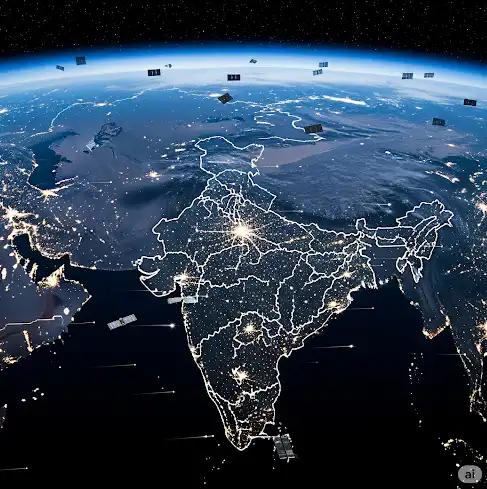While Elon Musk’s Starlink has finally crossed a major hurdle in India, the very regions Starlink hopes to serve could find themselves priced out of the revolution…
After years of red tape and uncertainty, the satellite internet venture now holds a Unified License. Official confirmation came from Communications Minister Jyotiraditya Scindia. This means Starlink can legally offer broadband services using its low-Earth orbit (LEO) satellite constellation.
It’s a big win, but not without limits. For starters, the rollout will be capped at 20 lakh users. Pricing is still up in the air, though early chatter points to speeds between 25 to 220 Mbps starting at a likely cost of around ₹3,500 per month. Starlink’s main pitch is clear: reach parts of India that traditional telcos have long ignored.
Remote villages and patchy rural zones are its target market. That being said, OneWeb, backed by Bharti, and Amazon’s Project Kuiper are also preparing for orbit. Whether Starlink can outpace them on Indian turf is a story still unfolding.
Costs, Caps, and Constraints

The Department of Telecommunications has capped the number of Starlink users at 20 lakh, keeping a tight leash on early expansion (citing spectrum and network constraints). As we already mentioned, while the monthly plan may range between ₹3,000 to ₹4,200 depending on location and usage for speeds between 50 Mbps to 220 Mbps, reports suggest a one-time hardware cost of ₹35,000 may also apply. And while these aren’t mass-market numbers, they’re not meant to be.
Starlink is targeting villages, far-flung areas, and terrain where laying fiber is either impractical or decades away. This is less about stealing market share from Jio or Airtel and more about plugging into areas they can’t reach. In fact, officials are framing this as a tool for rural empowerment, education, telemedicine, disaster relief, and e-governance, which could all benefit if the tech lives up to its promise.
The license Starlink received is a Unified License with Global Mobile Personal Communication by Satellite (GMPCS) authorization, a crucial bureaucratic hurdle that’s kept Musk’s team at bay since 2022. Back then, the company prematurely took preorders and was forced to refund customers when it lacked regulatory clearance.
This time, things are looking more positive, especially with satellite internet being positioned as part of India’s Digital India mission. Minister Scindia was quoted stating “Frameworks for spectrum allocation and gateway establishment are ready, ensuring smooth rollout.” That said, Starlink still needs to finalize its commercial strategy, establish local ground infrastructure, and maybe even find an Indian partner for logistics and compliance.
With OneWeb and Amazon’s Project Kuiper both inching closer to operational status, Starlink may not have the segment to itself for long. But its first-mover advantage, global experience, and SpaceX’s launch muscle might help it move faster, assuming India’s regulatory winds continue to blow in its favor.
India-Specific Challenges

What gives Starlink an edge in India is the chance to fix a problem no one else has cracked yet. In rural parts of the country, basic internet access is still a luxury for close to 40% of the population. Forget fiber; even patchy mobile data is hard to come by in many places. That’s where satellite internet comes in. It skips the whole tower-cable drama and beams connectivity straight from orbit.
If Starlink can deliver stable speeds to a village tucked away in Ladakh or a flood-prone zone in Assam, the impact could be huge. It’s about powering education, farming tools, e-commerce, and local startups. The only hitch? Cost. At ₹4,200 a month, it’s simply too steep for most rural users. Unless there’s help from the government or a new pricing model, the people who need it most may end up shut out.
What’s also interesting is how Starlink’s India strategy echoes its moves in other underserved regions, rural America, parts of Africa, and remote Australia. The model is simple: offer basic access first, scale slowly, and use early adopter feedback to refine service. Unlike terrestrial telcos, Starlink isn’t bound by geographic licensing in the same way, once the constellation is up, it can serve anywhere its satellites pass over.
That global consistency is a strength, but also a challenge in India’s complex market. Regulatory compliance, data localization, and spectrum sharing are all issues that Starlink will still need to navigate through. Additionally, early tests in other countries have shown performance fluctuations. India, with its extreme weather, dense monsoons, and dust-laden skies, will be its own proving ground.
A Starry Outlook
With its long-awaited license in hand, Starlink is finally poised to bring satellite internet to India. But as opposed to a grand consumer launch, this seems more like a targeted, regulated experiment aimed at the parts of India the mainstream telecom industry hasn’t yet cracked. While Elon Musk’s name will grab the headlines, the real story will unfold in India’s remote villages, where farmers, schoolchildren, and field doctors may soon be able to tap into the SpaceX-launched LEO network. The initial cap of 20 lakh users ensures this will be a controlled rollout, but that may be for the best.
If it works, Starlink could set a precedent for how emerging nations can leapfrog outdated infrastructure models. However, if for some reason it stumbles on pricing, reliability, or regulations, it may lose it’s newfound market to alternatives like OneWeb which has significant Indian tie-ups like Barti Enterprises (major investor), HCIPL, and ISRO.
Either way, India’s internet landscape just got a lot more interesting.
In case you missed:
- India’s first Aatmanirbhar semiconductor chip is finally here!
- Tesla’s India Launch: It’s not about the Model Y, it’s about the AI!
- The Sodium-Ion Breakthrough That Could Unplug Lithium’s Reign
- India’s Mappls Revolution: The Swadeshi Push to Dethrone Google Maps
- One Chip to Rule Them All: The 6G Chip at 100 Gbps!
- Tata Electronics to Manufacture Intel Chips & AI Laptops in India!
- India’s first Aatmanirbhar Chip Fab: TATA leads the way!
- India, iPhones, China & Trump: The Foxconn Story!
- Age of Bhaarat: India’s Aatmanirbhar Leap into AAA MMORPG Gaming
- India’s First Paid Chip Prototype: Kaynes Fires the Starting Shot










